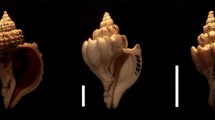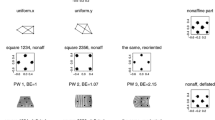Abstract
Formal spaces have become commonplace conceptual and computational tools in a large array of scientific disciplines, including both the natural and the social sciences. Morphological spaces (morphospaces) are spaces describing and relating organismal phenotypes. They play a central role in morphometrics, the statistical description of biological forms, but also underlie the notion of adaptive landscapes that drives many theoretical considerations in evolutionary biology. We briefly review the topological and geometrical properties of the most common morphospaces in the biological literature. In contemporary geometric morphometrics, the notion of a morphospace is based on the Euclidean tangent space to Kendall’s shape space, which is a Riemannian manifold. Many more classical morphospaces, such as Raup’s space of coiled shells, lack these metric properties, e.g., due to incommensurably scaled variables, so that these morphospaces typically are affine vector spaces. Other notions of a morphospace, like Thomas and Reif’s (1993) skeleton space, may not give rise to a quantitative measure of similarity at all. Such spaces can often be characterized in terms of topological or pretopological spaces.
The typical language of theoretical and evolutionary biology, comprising statements about the “distance” among phenotypes in an according space or about different “directions” of evolution, is not warranted for all types of morphospaces. Graphical visualizations of morphospaces or adaptive landscapes may tempt the reader to apply “Euclidean intuitions” to a morphospace, whatever its actual topology might be. We discuss the limits of metaphors such as the developmental hourglass and adaptive landscapes that ensue from the geometric properties of the underlying morphospace.
Similar content being viewed by others
References
Alberch P (1991) From genes to phenotype: Dynamical systems and evolvability. Genetica 85: 5–11
Amari S (1985) Differential-Geometrical Methods in Statistics. Berlin: Springer.
Arnold SJ, Pfrender ME, Jones A (2001) The adaptive landscape as a conceptual bridge between micro and macroevolution. Genetica 112–113: 9–32.
Bininda-Emonds ORP, Jeffery EJ, Richardson MK (2003) Inverting the hourglass: Quantitative evidence against the phylotypic stage in vertebrate development. Proceedings of the Royal Society London B 270: 341–346.
Blackith RE, Reyment RA (1971) Multivariate Morphometrics. London: Academic Press.
Bookstein FL (1989) Principal warps: Thin plate splines and the decomposition of deformations. IEEE Transactions on Pattern Analysis and Machine Intelligence 11: 567–585.
Bookstein F (1991) Morphometric Tools for Landmark Data: Geometry and Biology. Cambridge: Cambridge University Press.
Bookstein F (1998) A hundred years of morphometrics. Acta Zoologica Academiae Scientarium Hungaricae 44: 7–59.
Dryden IL, Mardia KV (1998) Statistical Shape Analysis. New York: Wiley.
Duboule D (1994) Temporal colinearity and the phylotypic progression: A basis for the stability of a vertebrate Bauplan and the evolution of morphologies through heterochrony. Development (Suppl): 135–142.
Fontana W, Schuster P (1998a) Continuity in evolution: On the nature of transitions. Science 280: 1451–1455.
Fontana W, Schuster P (1998b) Shaping space: The possible and the attainable in RNA genotype-phenotype mapping. Journal of Theoretical Biology 194: 491–515.
Foote M (1993) Contributions of individual taxa to overall morphological disparity. Paleobiology 19: 403–419.
Galis F, Metz JAJ (2001) Testing the vulnerability of the phylotypic stage: On modularity and evolutionary conservation. Journal of Experimental Zoology 291: 195–204.
Galton F (1888) Co-relations and their measurement, chiefly from anthropometric data. Proceeding of the Royal Society 45: 135–145.
Galton F (1907) Classification of portraits. Nature 76: 617–618.
Gavrilets S (2004) Fitness Landscapes and the Origin of Species. Princeton, NJ: Princeton University Press.
Gould SJ (1977) Ontogeny and Phylogeny. Cambridge, MA: Harvard University Press.
Hofbauer J, Sigmund K (1998) Evolutionary Games and Population Dynamics. Cambridge: Cambridge University Press.
Huttegger S, Mitteroecker P (in preparation) The geometry of phenotype spaces: Invariance and meaningfulness.
Johnson N (2008) Sewall Wright and the development of shifting balance theory. Nature Education 1(1).
Johnson RA, Wichern DW (1998) Applied Multivariate Statistical Analysis. Upper Saddle River, NJ: Prentice Hall.
Kaplan J (2008) The end of the adaptive landscape metaphor? Biology and Philosophy 23: 625–638.
Kendall D (1981) The statistics of shape. In: Interpreting Multivariate Data (Barnett V, ed), 75–80. New York: Wiley.
Kendall D (1984) Shape manifolds: Procrustean metrics and complex projective spaces. Bulletin of the London Mathematical Society 16: 81–121.
Klingenberg CP, McIntyre GS (1998) Geometric morphometrics of developmental instability: Analyzing patterns of fluctuating asymmetry with Procrustes methods. Evolution 52: 1363–1375.
Manfreda E, Mitteroecker P, Bookstein FL, Schaefer K (2006) Functional morphology of the first cervical vertebra in humans and non-human primates. Anatomical Record, Part B: The New Anatomist 289: 184–194.
Marcus LF (1990) Traditional morphometrics. In: Proceedings of the Michigan Morphometrics Workshop (Rohlf FJ, Bookstein FL, eds), 77–122. Ann Arbor, MI: University of Michigan Museums.
Marcus LF, Hingst-Zaher E, Zaher H (2000) Application of landmark morphometrics to skulls representing the orders of living mammals. Hystrix, Italian Journal of Mammology 11: 27–47.
Mardia KV, Bookstein F, Moreton I (2000) Statistical assessement of bilateral symmetry of shapes. Biometrika 87: 285–300.
Mardia KV, Kent JT, Bibby JM (1979) Multivariate Analysis. London: Academic Press.
McGhee GR (1999) Theoretical Morphology: The Concept and Its Applications. New York: Columbia University Press.
McGhee GR (2007) The Geometry of Evolution: Adaptive Landscapes and Theoretical Morphospaces. Cambridge: Cambridge University Press.
Milne-Edwards H (1844) Considérations sur quelques principes relatifs à la classification naturelle des animaux. Annales des Sciences Naturelles (Zoologie) (Série 3) 1: 65–99.
Mitteroecker P, Bookstein FL (2007) The conceptual and statistical relationship between modularity and morphological integration. Systematic Biology 56: 818–836.
Mitteroecker P, Bookstein FL (2008) The evolutionary role of modularity and integration in the hominoid cranium. Evolution 62: 943–958.
Mitteroecker P, Bookstein FL (2009) The ontogenetic trajectory of the phenotypic covariance matrix, with examples from craniofacial shape in rats and humans. Evolution 63: 727–737.
Mitteroecker P, Gunz P (2009) Advances in geometric morphometrics. Evolutionary Biology 36: 235–247.
Mitteroecker P, Gunz P, Bernhard M, Schaefer K, Bookstein F (2004) Comparison of cranial ontogenetic trajectories among great apes and humans. Journal of Human Evolution 46: 679–697.
Niklas KJ, Kerchner V (1984) Mechanical and photosynthetic constraints on the evolution of plant shape. Paleobiology 10: 79–101.
Pearson K, Morant GM (1934) The Wilkinson head of Oliver Cromwell and its relationship to busts, masks and painted portraits. Biometrika 26: 1–116.
Pigliucci M (2008) Sewall Wright’s adaptive landscapes: 1932 vs. 1988. Biology and Philosophy 23: 591–603.
Raff R (1996) The Shape of Life: Genes, Development, and the Evolution of Animal Form. Chicago: University of Chicago Press.
Rasskin-Gutman D, Buscalioni AD (1996) Affine transformation as a model of virtual form change for generating morphospaces. In: Advances in Morphometrics (Marcus LF, Corti M, Loy A, Slice D, Naylor G, eds), 169–178. New York: Plenum Press.
Raup DM (1966) Geometric analysis of shell coiling: General problems. Journal of Paleontology 40: 1178–1190.
Raup DM, Michelson A (1965) Theoretical morphology of the coiled shell. Science 147: 1294–1295.
Reyment RA (1991) Multidimensional Paleobiology. New York: Pergamon Press.
Richardson MK, Hanken J, Gooneratne ML, Pieau C, Raynaud A, Selwood L, Wright GM (1997) There is no highly conserved embryonic stage in the vertebrates: Implications for current theories of evolution and development. Anatomy and Embryology 196: 91–106.
Rohlf FJ (1999) Shape statistics: Procrustes superimpositions and tangent spaces. Journal of Classification 16: 197–223.
Rohlf FJ, Marcus LF (1993) A revolution in morphometrics. Trends in Ecology and Evolution 8: 129–132.
Rohlf FJ, Slice DE (1990) Extensions of the Procrustes method for the optimal superimposition of landmarks. Systematic Zoology 39: 40–59.
Rohlf FJ, Sokal RR (1965) Coefficients of correlation and distance in numerical taxonomy. University of Kansas Science Bulletin 45: 3–27.
Schindel DE (1990) Unoccupied morphospace and the coiled geometry of gastropods: Architectural constraints or geometric covariation? In: Causes of Evolution (Ross RA, Allmon WD, eds), 270–304. Chicago: University of Chicago Press.
Simpson GG (1944) Tempo and Mode in Evolution. New York: Columbia University Press.
Slice DE (2001) Landmark coordinates aligned by procrustes analysis do not lie in Kendall’s shape space. Systematic Biology 50: 141–149.
Slice DE (2005) Modern Morphometrics in Physical Anthropology. Dordrecht, the Netherlands: Kluwer.
Small C (1996) The Statistical Theory of Shape. New York: Springer.
Sneath P, Sokal R (1973) Numerical Taxonomy. San Francisco, CA: Freeman.
Sokal RR (1961) Distance as a measure of taxonomic similarity. Systematic Zoology 10: 70–79.
Stadler PF (2002) Fitness landscapes. In: Biological Evolution and Statistical Physics (Lässig M, Valleriani A, eds), 187–207. Berlin: Springer.
Stadler BMR, Stadler PF (2004) The topology of evolutionary biology. In: Modeling in Molecular Biology (Ciobanu G, Rozenberg G, eds), 267–286. Berlin: Springer.
Stadler BMR, Stadler PF, Shpak M, Wagner GP (2002) Recombination spaces, metrics, and pretopologies. Zeitschrift för Physikalische Chemie 216: 217–234.
Stadler BMR, Stadler PF, Wagner G, Fontana W (2001) The topology of the possible: Formal spaces underlying patterns of evolutionary change. Journal of Theoretical Biology 213: 241–274.
Suppes P, Krantz DH, Luce RD, Tversky A (1989) Foundations of Measurement, Vol. II: Geometrical, Threshold, and Probabilistic Representations. New York: Academic Press.
Thomas RDK, Reif W-E (1993) The skeleton space: A finite set of organic designs. Evolution 47: 341–360.
Thomas RDK, Shearman RM, Stewart GW (2000) Evolutionary exploitation of design options by the first animals with hard skeletons. Science 288: 1239–1242.
Thompson DAW (1917) On Growth and Form. Cambridge: Cambridge University Press.
von Baer KE (1828) Entwicklungsgeschichte der Thiere: Beobachtung und Reflexion. Königsberg, Germany: Bornträger.
Wagner GP, Altenberg L (1996) Complex adaptations and the evolution of evolvability. Evolution 50: 967–976.
Wright S (1932) The roles of mutation, inbreeding, crossbreeding, and selection in evolution. Proceedings of the Sixth International Congress of Genetics 1: 356–366.
Wright S (1988) Surfaces of selective value revisited. American Naturalist 131: 115–123.
Author information
Authors and Affiliations
Corresponding author
Rights and permissions
About this article
Cite this article
Mitteroecker, P., Huttegger, S.M. The Concept of Morphospaces in Evolutionary and Developmental Biology: Mathematics and Metaphors. Biol Theory 4, 54–67 (2009). https://doi.org/10.1162/biot.2009.4.1.54
Received:
Accepted:
Published:
Issue Date:
DOI: https://doi.org/10.1162/biot.2009.4.1.54




